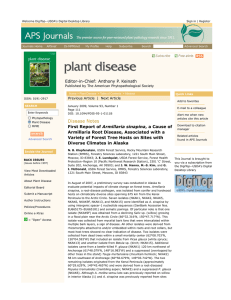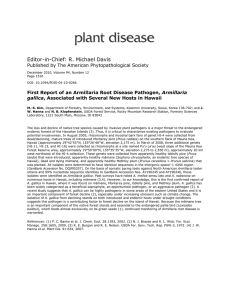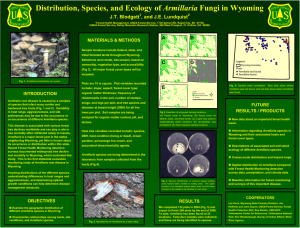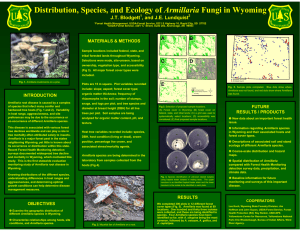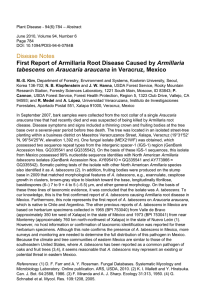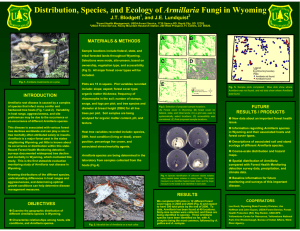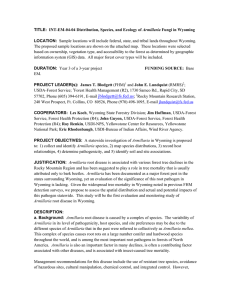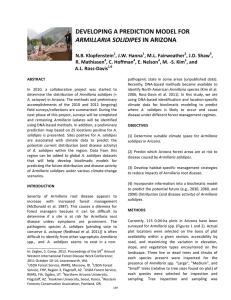S P A N
advertisement
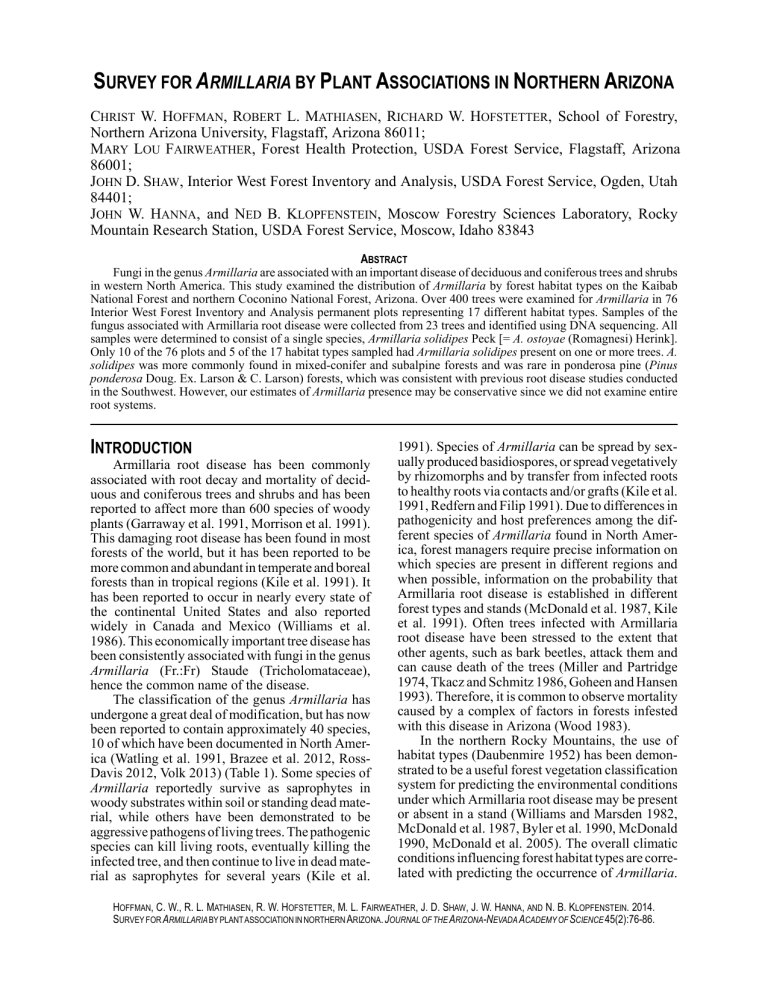
SURVEY FOR ARMILLARIA BY PLANT ASSOCIATIONS IN NORTHERN ARIZONA CHRIST W. HOFFMAN, ROBERT L. MATHIASEN, RICHARD W. HOFSTETTER, School of Forestry, Northern Arizona University, Flagstaff, Arizona 86011; MARY LOU FAIRWEATHER, Forest Health Protection, USDA Forest Service, Flagstaff, Arizona 86001; JOHN D. SHAW, Interior West Forest Inventory and Analysis, USDA Forest Service, Ogden, Utah 84401; JOHN W. HANNA, and NED B. KLOPFENSTEIN, Moscow Forestry Sciences Laboratory, Rocky Mountain Research Station, USDA Forest Service, Moscow, Idaho 83843 ABSTRACT Fungi in the genus Armillaria are associated with an important disease of deciduous and coniferous trees and shrubs in western North America. This study examined the distribution of Armillaria by forest habitat types on the Kaibab National Forest and northern Coconino National Forest, Arizona. Over 400 trees were examined for Armillaria in 76 Interior West Forest Inventory and Analysis permanent plots representing 17 different habitat types. Samples of the fungus associated with Armillaria root disease were collected from 23 trees and identified using DNA sequencing. All samples were determined to consist of a single species, Armillaria solidipes Peck [= A. ostoyae (Romagnesi) Herink]. Only 10 of the 76 plots and 5 of the 17 habitat types sampled had Armillaria solidipes present on one or more trees. A. solidipes was more commonly found in mixed-conifer and subalpine forests and was rare in ponderosa pine (Pinus ponderosa Doug. Ex. Larson & C. Larson) forests, which was consistent with previous root disease studies conducted in the Southwest. However, our estimates of Armillaria presence may be conservative since we did not examine entire root systems. INTRODUCTION Armillaria root disease has been commonly associated with root decay and mortality of deciduous and coniferous trees and shrubs and has been reported to affect more than 600 species of woody plants (Garraway et al. 1991, Morrison et al. 1991). This damaging root disease has been found in most forests of the world, but it has been reported to be more common and abundant in temperate and boreal forests than in tropical regions (Kile et al. 1991). It has been reported to occur in nearly every state of the continental United States and also reported widely in Canada and Mexico (Williams et al. 1986). This economically important tree disease has been consistently associated with fungi in the genus Armillaria (Fr.:Fr) Staude (Tricholomataceae), hence the common name of the disease. The classification of the genus Armillaria has undergone a great deal of modification, but has now been reported to contain approximately 40 species, 10 of which have been documented in North America (Watling et al. 1991, Brazee et al. 2012, RossDavis 2012, Volk 2013) (Table 1). Some species of Armillaria reportedly survive as saprophytes in woody substrates within soil or standing dead material, while others have been demonstrated to be aggressive pathogens of living trees. The pathogenic species can kill living roots, eventually killing the infected tree, and then continue to live in dead material as saprophytes for several years (Kile et al. 1991). Species of Armillaria can be spread by sexually produced basidiospores, or spread vegetatively by rhizomorphs and by transfer from infected roots to healthy roots via contacts and/or grafts (Kile et al. 1991, Redfern and Filip 1991). Due to differences in pathogenicity and host preferences among the different species of Armillaria found in North America, forest managers require precise information on which species are present in different regions and when possible, information on the probability that Armillaria root disease is established in different forest types and stands (McDonald et al. 1987, Kile et al. 1991). Often trees infected with Armillaria root disease have been stressed to the extent that other agents, such as bark beetles, attack them and can cause death of the trees (Miller and Partridge 1974, Tkacz and Schmitz 1986, Goheen and Hansen 1993). Therefore, it is common to observe mortality caused by a complex of factors in forests infested with this disease in Arizona (Wood 1983). In the northern Rocky Mountains, the use of habitat types (Daubenmire 1952) has been demonstrated to be a useful forest vegetation classification system for predicting the environmental conditions under which Armillaria root disease may be present or absent in a stand (Williams and Marsden 1982, McDonald et al. 1987, Byler et al. 1990, McDonald 1990, McDonald et al. 2005). The overall climatic conditions influencing forest habitat types are correlated with predicting the occurrence of Armillaria. HOFFMAN, C. W., R. L. MATHIASEN, R. W. HOFSTETTER, M. L. FAIRWEATHER, J. D. SHAW, J. W. HANNA, AND N. B. KLOPFENSTEIN. 2014. SURVEY FOR ARMILLARIA BY PLANT ASSOCIATION IN NORTHERN ARIZONA. JOURNAL OF THE ARIZONA-NEVADA ACADEMY OF SCIENCE 45(2):76-86. 77 ARMILLARIA ROOT DISEASE IN NORTHERN ARIZONA g HOFFMAN ET AL. Table 1. Species of Armillaria found in North America (Baumgartner and Rizzo 2001, Kim et al. 2010, Elias-Roman et al. 2013, Brazee et al. 2013, Nelson et al. 2013, Volk 2013). Species Distribution Amillaria solidipes Peck/ostoyae (Romagnesi) Herink Northern conifer zone, occasionally on hardwoods A. gemina Bérubé & Dessurealt Northeastern United States, eastern Canada A. calvescens Bérubé & Dessurealt Eastern Canada to Michigan and Wisconsin A. sinapina Bérubé & Dessurealt Northern conifer zone, but typically hardwoods in the East and conifers in the West A. mellea (Vahl:Fries) Kummer Hardwood zone, mostly southeastern United States north to Iowa and Wisconsin and south to Oklahoma, Texas, and Mexico. Eastern distribution from Florida to the Appalachians to Québec. Known from Arizona, California, and Oregon but not other areas of the West A. gallica Marxmüller & Romagnesi Hardwoods in South, Northeast, Midwest, and Mexico; Arizona, California, and the Pacific Northwest A. nabsnona Volk & Burdsall Idaho, Washington, Oregon, Alaska, and British Columbia A. cepistipes Velenovsky Washington and British Columbia A. tabescens (Scopoli) Emel Southeastern United States into the Northwest, west to Ohio, also farther west and north on shores of Great Lakes and south to Veracruz, Mexico A. altimontana Brazee, B. Ortiz, Banik & D. L. Lindner Idaho, Washington, Oregon, California, and British Columbia In the northern Rocky Mountains, habitat types characterized as cold-dry or hot-dry environments were found to be outside the ecological range of Armillaria and excessively cold or moist sites may also limit the growth and development of Armillaria and hence have little of the fungus present (McDonald et al. 1987). In the Southwest, where many of the forests are characterized by hot-dry or warm-dry climatic conditions, Armillaria root disease is considered important only on more mesic sites (Wood 1983). However, in northern Arizona few studies have been conducted to examine the distribution of Armillaria or identify the species of Armillaria present using the currently recognized classification of the genus. In the Southwest, habitat types are often called plant associations (Stuever 1997) and we have adopted this terminology since the two terms are synonymous. Historically, Armillaria root disease was thought to be caused by a single species, Armillaria mellea (Vahl:Fr.) Kummer. Although Wood (1983) applied the concept of using Armillariella in place of Armillaria in a study in the southwestern United States, the use of the previous genus was invalidated by Watling et al. (1982) and is no longer used as an obligate synonym for Armillaria (Volk 2013). Under the current classification system for Armillaria, the distribution of A. mellea is confined to the eastern and midwestern United States and California (Volk 2013). However, A. mellea was reported from southeastern Arizona on oaks (Quercus spp.) by Gilbertson and Bigelow (1998) based on morphology, and recently confirmed (Nelson et al. 2013). The primary species of Armillaria associated with a root disease of conifers throughout the western United States has now been designated as A. solidipes Peck [=A. ostoyae (Romagnesi) Herink] (Burdsall and Volk 2008), pending a vote for nomenclatural conservation (Hunt et al. 2011), and was the species morphologically identified in a study in New Mexico (Omdal et al. 1995). Gilbertson and Bigelow (1998) also reported A. solidipes (as A. ostoyae) in the Sky Islands of southeastern Arizona on several conifers and quaking aspen (Populus tremuloides Michx.). However, the identification of Armillaria species that occur in Arizona using DNA-based techniques is needed, as well as additional information on the distribution and abundance of Armillaria in the northern part of the state. ARMILLARIA ROOT DISEASE IN NORTHERN ARIZONA g HOFFMAN ET AL. Today it is possible to identify species of Armillaria using DNA sequencing techniques (Kim et al. 2006, Ross-Davis et al. 2012). Kim et al. (2006) examined rDNA sequences for three regions and used amplified fragment length polymorphisms (AFLPs) to assess the phylogenetic relationships of several species of Armillaria. They concluded that ribosomal DNA intergenic spacer sequences (IGS-1) and AFLP genetic markers could be used to potentially distinguish the North American species of Armillaria. In addition, the phylogenetic relationships among 15 globally diverse Armillaria species and eight Japanese species were examined and separated using partial sequences of the translation elongation factor-1 alpha (tef-1α) gene (Maphosa et al. 2006, Hasegawa et al. 2010). DNA based identification of Armillaria has also been used in North America and can now confidently differentiate species (Ross-Davis et al. 2012). Five clades have been identified using the tef-1α gene which clearly separated the North American species of Armillaria. Therefore, current molecular methods have been shown to be effective at correctly identifying the currently recognized North American species of Armillaria (Ross-Davis et al. 2012). Because little information was available on the species of Armillaria that occur in northern Arizona, the hosts affected, or the distribution of the pathogen by forest type or plant association, this study was initiated in 2011 in cooperation with USDA Forest Service: Rocky Mountain Research Station (RMRS); Interior West Forest Inventory and Analysis program (IW-FIA); and Forest Health Protection, Southwest Region. Permanent plots established by IW-FIA on the Kaibab and Coconino National Forests, Arizona, were used as sampling sites. These plots were used because they allowed the accomplishment of several ancillary goals: 1) this study served as a pilot test of methodology that could potentially be added to FIA protocols, 2) because the FIA program uses a systematic sampling design, the results of this study can be used to estimate the proportion of area with Armillaria present, and 3) because the plots are part of a continuous forest inventory and monitoring system, the results can serve as a baseline for future comparisons. Plots representing 17 plant associations on three ranger districts were surveyed, in which dead and living trees with or without root disease symptoms were examined for the presence of Armillaria. Samples of Armillaria were collected when observed and sent to the RMRS Forestry Sciences Laboratory in Moscow, Idaho, for positive identification based on DNA sequences of partial Large Subunit and intergenic spacer 1 (LSU-IGS1) regions of ribosomal DNA and tef-1α. Here we report our 78 findings, which support previous reports that Armillaria root disease is not common in northern Arizona and that the disease is commonly associated with only one species of Armillaria. METHODS This study used permanent plots established by the IW-FIA program on the Kaibab and Coconino National Forests in northern Arizona. Plots on the North Kaibab, Williams, and Flagstaff Ranger Districts were selected based on ownership, accessibility, and plant association. A total of 76 plots were sampled that represented 17 forest plant associations (Table 2 and Fig. 1). Rather than splitting plant associations into phases, plots representing a phase were grouped under each major plant association sampled. Plots were visited during the summers of 2011 and 2012. Plots established by IW-FIA consist of four circular subplots (radius 7.3 m, 0.02 ha) (USDA Forest Service 2011) (Fig. 2). Each unit has a central subplot with three additional subplots established 36.6 m from its center at azimuths of 360°, 240°, and 120°. Each sampling unit was classified by elevation, aspect, forest type, soil type, and plant association. Standard forest inventory data collected from the four subplots included trees species, diameter breast height (dbh, 1.4 m above the ground), tree heights, and information on downedwoody material. To avoid disturbance associated with surveys for Armillaria within the IW-FIA subplots, circular supplemental plots (0.04 ha) were established 36.6 m from the center of the central IW-FIA subplot at an azimuth of 300° (Fig. 2). Only one supplemental plot was established for each set of IW-FIA subplots sampled. In each supplemental subplot, one live or dead tree of each species present in the plot was examined for the presence of Armillaria by each of the following dbh classes: <20, 20-40, and >40 cm whenever possible. At least three trees were examined in each plot. Dead trees or live trees with symptoms of root disease were given priority for examination over live trees with no root disease symptoms. Only the species and diameter (dbh, nearest cm) of trees sampled for the presence of Armillaria were recorded for each supplemental plot. Examination of trees for the presence of Armillaria was conducted by excavating at least one main root to a radial distance of 0.8 m from the bole. When mycelia fans were present on roots, samples were collected by carefully removing a section of the infected root so the integrity of the bark remained intact. The size of sampled root sections or mycelia fans varied depending on the size of the infected root or bole. Up to three samples were collected from each infected tree. Root samples that 79 ARMILLARIA ROOT DISEASE IN NORTHERN ARIZONA g HOFFMAN ET AL. Table 2. Number of plots surveyed and number of plots with Armillaria by plant association on the Flagstaff Ranger District, Coconino National Forest and the North Kaibab and Williams Ranger Districts, Kaibab National Forest, Arizona. Plant association acronyms (e.g., PSME/FEAR) and plant species classications follow Stuever (1997).See Appendix 1 for a list of common and scientific names of plants used in the name of plant associations. Ranger district Flagstaff Williams North Kaibab Total Number of plots Plots with Amillaria Subalpine fir/Nevada pea (ABLA/LALAL3) 1 0 White fir/Creeping barberry (ABCO/MARE11) 1 0 Douglas-fir/Arizona fescue (PSME/FEAR) 2 0 Douglas-fir/Creeping barberry (PSME/MARE11) 1 0 Douglas-fir/Gambel oak (PSME/QUGA) 1 1 Ponderosa pine/Arizona fescue (PIPO/FEAR) 7 1 Ponderosa pine/Blue grama (PIPO/BOGR2) 7 0 Ponderosa pine/Mountain muhly (PIPO/MUMO) 5 0 Douglas-fir/Mountain muhly (PSME/MUMO) 1 0 Ponderosa pine/Arizona fescue 7 0 Ponderosa pine/Blue grama 3 0 Ponderosa pine/Mountain muhly 2 0 Subalpine fir/Common juniper (ABLA/JUCO6) 5 3 Engelmann spruce/Fleabane (PIEN/EREX4) 3 0 Engelmann spruce/Maple (PIEN/ACGL) 1 0 Blue spruce/Dryspike sedge (PIPU/CAFO3) 4 2 Blue spruce/Fleabane (PIPU/EREX4) 1 0 White fir/Arizona fescue (ABCO/FEAR) 2 0 White fir/Creeping barberry 4 2 White fir/Dryspike sedge (ABCO/CAFO3) 3 0 Douglas-fir/Arizona fescue 1 0 Douglas-fir/Gambel oak 1 0 Ponderosa pine/Arizona fescue 4 1 Ponderosa pine/Blue grama 2 0 Ponderosa pine/Mountain muhly 3 0 Ponderosa pine/Gambel oak (PIPO/QUGA) 4 0 76 10 Plant association ARMILLARIA ROOT DISEASE IN NORTHERN ARIZONA g HOFFMAN ET AL. Figure 1. Approximate locations of 76 plots surveyed for Armillaria on the Kaibab and Coconino National Forests, Arizona. 80 81 Figure 2. Plot design for Intermountain West Forest Inventory and Analysis sample plots with the supplemental Armillaria plot placed at a 300E azimuth from the center of the plot cluster. appeared to be colonized by Armillaria were collected from 42 trees. Each Armillaria sample was placed in a paper bag and all the bags collected for a tree were placed in a Ziploc bag and kept in a cooler while in the field and then refrigerated. Within 2 weeks, samples were mailed overnight on ice to the RMRS Forestry Sciences Laboratory, Moscow, Idaho. Armillaria was isolated from mycelial fans, rhizomorphs, or wood; then established in culture on 3% malt-agar medium (3% malt extract, 1.5% peptone, 3% glucose, and 1.5% agar) and incubated at 22EC in the dark. Template DNA was collected directly from scrapings of actively growing mycelia or by using DNeasy Plant Mini DNA extraction kits (Qiagen Inc., Valencia, CA, USA) to extract DNA from ca. 100 mg of mycelia that was cultured on 0.2-µm-pore nylon filters (Millipore Corp., Billerica, Massachusetts, USA) overlaying the culture medium. Extracted DNA samples were used for PCR and sequencing of the partial Large Subunit and intergenic spacer 1 (LSU-IGS1) regions of the ribosomal DNA was used to identify which species of Armillaria was associated with each sample (Kim et al. 2006). Species identify was confirmed using the tef-1α gene (Ross-Davis et al. 2012). Armillaria sequences were identified based on similarity (>95%) and phylogenic placement using SplitsTrees4 with default parameters (Huson and Bryant 2006) when compared against reference sequences from Kim et al. (2006), Hanna et al. (2007), Ross-Davis et al. (2012) and/or EliasRoman et al. (2013). RESULTS A total of 76 supplemental 0.04-ha plots were inspected for Armillaria representing 17 plant ARMILLARIA ROOT DISEASE IN NORTHERN ARIZONA g HOFFMAN ET AL. associations (Table 2). A total of 10 plots had one or more trees with Armillaria: 8 of these plots were on the North Kaibab Ranger District (Kaibab Plateau) and two were on the Flagstaff Ranger District (Table 2 and Fig. 1). This represented 21% and 8% of the plots surveyed on those districts, respectively. Armillaria was not detected on the Williams Ranger District. A single FIA plot in Arizona has an expansion factor of approximately 2,500 ha, depending on the actual number of plots surveyed at a given point in the inventory cycle. Therefore, the simplified estimate is that the survey area of this study was approximately 190,000 ha, at least 25,000 ha (13%) of which would be expected to have Armillaria present. However, our estimates of Armillaria presence may be conservative since we did not examine entire root systems. Armillaria was found in 5 of the 17 plant associations sampled. It was most often found in plant associations that represented warm-dry climatic conditions of the subalpine or mixed-conifer forest types (Stuever 1997); the subalpine fir/common juniper (ABLA/JUCO6), white fir/creeping barberry (ABCO/MARE11), and Douglas-fir/Gambel oak (PSME/QUGA) plant associations (Tables 2 and 3). Armillaria was also detected in one plant association that represented cold-wet climatic conditions of the mixed conifer forest type; the blue spruce/ dryspike sedge (PIEN/CAFO3) plant association. Although 11 plots were sampled that represented three additional subalpine (PIEN/ACGL, PIEN/ EREX4, and ABLA/LALAL3) and four mixed conifer forest plant associations (PIPU/EREX4, ABCO/ FEAR, ABCO/CAFO3, and PSME/MUMO), Armillaria was not detected in any of them (Table 2). Armillaria was only found in one ponderosa pine plant association, ponderosa pine/Arizona fescue (PIPO/FEAR), and although 18 plots were sampled for this plant association, the pathogen was only found in two plots; one each on the Kaibab and Coconino National Forests (Table 2). Although 25 plots representing three other ponderosa pine plant associations (PIPO/BOGR2, PIPO/MUMO, and PIPO/QUGA) were sampled, Armillaria was not detected. A total of 343 conifers and 82 deciduous species were surveyed in the 76 plots that were examined for Armillaria (Table 4). Of these, only 19 conifers and four quaking aspen had evidence of Armillaria (mycelial fans) on their roots or main boles that were detected by the survey method used. Rhizomorphs were rare with only two short segments collected from the bark of mycelial fan samples. The distribution of the 425 trees examined for Armillaria by diameter classes was: <20 cm – 239 trees; 20-40 cm – 117 trees; >40 cm – 69 trees. Of ARMILLARIA ROOT DISEASE IN NORTHERN ARIZONA g HOFFMAN ET AL. 82 Table 3. Number of trees surveyed (first number) and number of trees with Armillaria (second number) by tree species for the five plant associations where Armillaria was observed. Plant association acronyms follow Stuever (1997) and see Table 2. Ponderosa pine Quaking aspen Douglas-fir White fir Engelmann spruce Blue spruce PIPO/FEAR 44/3 0/0 0/0 0/0 0/0 0/0 PSME/QUGA 4/1 3/3 2/0 0/0 0/0 0/0 ABCO/MARE11 11/2 9/0 9/1 6/2 0/0 2/0 PIPU/CAFO3 7/3 6/0 0/0 3/0 3/2 3/0 ABLA/JUCO6 11/1 14/1 10/2 6/0 12/2 0/0 Total 76/10 32/4 21/3 15/2 15/4 5/0 Plant association the 23 trees in which Armillaria was detected, Table 4. Number of trees surveyed and number of trees and per11 were in the <20 cm class, 10 were in the centage with Armillaria by tree species in 76 plots on the Kaibab 20-40 cm class, and two were in the >40 cm and Coconino National Forests, Arizona. class. Armillaria was detected primarily on Number with Percent with Number dead trees; 19 of the 23 trees (83 %). Tree species examined Armillaria Armillaria The two most commonly surveyed tree species were ponderosa pine (Pinus Ponderosa pine 189 10 5 ponderosa Dougl. ex Larson & C. Larson) and quaking aspen. Both of these species were Quaking aspen 65 4 6 infrequently associated with Armillaria; it was found on only 10 ponderosa pines (5%) and Douglas-fir 46 3 7 four aspen (6%) (Table 4). Four other conifers White fir 43 2 5 that were sampled in the subalpine and mixedconifer plant associations were Douglas-fir Engelmann spruce 27 4 15 (Pseudotsuga menziesii (Mirb.) Franco), white fir (Abies concolor (Gord. & Glend.) Blue spruce 20 0 0 Hilldebr., Engelmann spruce (Picea Gambel oak 11 0 0 engelmannii Parry ex Engelm.), and blue spruce (Picea pungens Engelm.). Armillaria Utah juniper 7 0 0 was also detected on three of these species and the incidence of infection was again very low: Colorado pinyon pine 6 0 0 Douglas-fir (7 %), white fir (5 %), and Engelmann spruce (15 %) (Table 4). Only a few Limber pine 4 0 0 trees of the following species were examined New Mexico locust 6 0 0 for Armillaria within the sample plots and the pathogen was not detected: Gambel oak Subalpine fir 1 0 0 (Quercus gambelii Nutt.), New Mexican locust (Robinia neomexicana Gray), Utah Total 425 23 5 juniper (Juniperus osteosperma (Torr.) Little), Colorado pinyon pine (Pinus edulis Engelm.), limber pine (Pinus flexilis James), and subalpine fir (Abies lasiocarpa (Hook.) Nutt.). DISCUSSION Based on DNA sequences of the LSU-IGS1 and Recently, it was determined that A. solidipes the tef-1α gene, isolates from the 23 trees were all was the appropriate name for the species associated identified as Armillaria solidipes (= A. ostoyae). with Armillaria root disease of conifers in the West (Burdsall and Volk 2008); however, Hunt et al. 83 (2011) argued that A. solidipes is an ambiguous species which is probably not conspecific with A. ostoyae and as a result have proposed that A. ostoyae be conserved over A. solidipes. Thus, the appropriate taxonomy for the Armillaria sp. that was recovered in this study remains controversial. Other species of Armillaria that have been reported in Arizona include A. mellea and A. gallica Marxmüller & Romagnesi. The reports of A. mellea have been from the Chiricahua, Pinaleno, Santa Catalina, and Santa Rita Mountains in southeastern Arizona on three species of oak (Gilbertson and Bigelow 1998) and the report of A. gallica is from the Mogollon Rim on Douglas-fir in north-central Arizona (Nelson et al. 2013). Other species of Armillaria that are of interest in Arizona include A. sinapina (Table 1) and a recently discovered undescribed species from the State of Mexico, Mexico (Elias-Roman et al. 2013). However, it is improbable that these taxa are the common species of Armillaria associated with root disease in northern Arizona based on our results, but further sampling may discover that these other species are more common than what our findings suggest. Armillaria solidipes can be highly pathogenic on conifers throughout the western United States, but we also found it infecting aspen in subalpine forests on the north Kaibab Plateau and in mixed conifer forests on the San Francisco Peaks. Armillaria was most often found on dead trees and was probably associated with mortality of the infected trees. However, insects that attack weakened trees (particularly bark beetles of conifers) may have also contributed to their death. Mortality of ponderosa pine in northern Arizona has been shown to sometimes involve a complex of Armillaria root disease and bark beetles (Dendroctonus spp. and Ips spp., Scolytidae) or dwarf mistletoe (Arceuthobium spp., Viscaceae), or both (Wood 1983). However, we did not examine trees for the presence of insects or other diseases. Armillaria solidipes generally exists as both a pathogen and a saprophyte, but can exist in a nonpathogenic state in some forests (Redfern and Filip 1991). However, since we primarily found Armillaria associated with dead trees that displayed symptoms of disease, the populations we sampled in northern Arizona are considered pathogenic and likely contributed to the death of the infected trees. In comparison to the northern Rocky Mountains, northern Arizona evidently has a relatively low incidence of Armillaria root disease. McDonald et al. (1987) reported they found Armillaria associated with over 30% of each tree species they sampled in Washington, Idaho, and Montana. Our results found that the incidence of Armillaria on the ARMILLARIA ROOT DISEASE IN NORTHERN ARIZONA g HOFFMAN ET AL. trees we examined was only 15% or less. Wood (1983) also found a relatively low incidence of Armillaria root disease in Arizona. The highest incidence of the disease he reported for Arizona was for mixed conifer/spruce-fir forests on the ApacheSitgreaves National Forest where 24% of the dead trees he examined were infected with Armillaria. Wood (1983) only reported that 1, 7, and 12% of the dead ponderosa pines examined on the Kaibab, Apache-Sitgreaves, and Coconino National Forests, respectively, had Armillaria root disease. In New Mexico, he only found Armillaria root disease on 8% of the dead ponderosa pines surveyed on the Carson and Santa Fe National Forests. Our results also demonstrate a relatively low incidence of Armillaria on ponderosa pine in northern Arizona. This was particularly evident in the ponderosa pine habitat types sampled where A. solidipes was only found on 3 of the 110 ponderosa pines we surveyed; all 3 were in the PIPO/FEAR plant association (Table 3). Most of the infected ponderosa pines we observed (6 of 10 trees) were in mixed conifer forests. McDonald et al. (1987) hypothesized that Armillaria was probably completely absent from the ponderosa pine and limber pine plant associations in the northern Rocky Mountains. Our results indicated that Armillaria may also be absent from, or at least rare in, most ponderosa pine plant associations in northern Arizona, but additional surveys are needed in these plant associations because our sample sizes were relatively small compared to those of McDonald et al. (1987). Wood (1983) reported that 38% of the dead trees examined in the subalpine forests and 15% of the dead trees in the mixed-conifer forests of New Mexico had Armillaria root disease. Although we did not survey a large number of plant associations (4) or plots (10) in the subalpine forests of northern Arizona, the incidence of Armillaria was the highest (11% of the trees examined) in one of the plant associations (ABLA/JUCO6) compared to the other plant associations surveyed (PIEN/ACGL, PIEN/ EREX4, and ABLA/LALAL3). We also found Armillaria in three mixed-conifer forest plant associations (ABCO/MARE11, PSME/QUGA, and PIEN/CAFO3). This suggested that additional sampling should be completed in the subalpine and mixed-conifer forests of northern Arizona, particularly on the Kaibab Plateau where Armillaria has been observed to be more common in those forest types than in the ponderosa pine type (Wood 1983). Of the 38 plots we surveyed on the Kaibab Plateau in subalpine and mixed conifer forests, 21% were infested with Armillaria. In addition, we found that 15% of the Engelmann spruce examined were infected with Armillaria, which was the highest ARMILLARIA ROOT DISEASE IN NORTHERN ARIZONA g HOFFMAN ET AL. incidence of infection for a tree species surveyed. Therefore, it would be worthwhile to sample additional habitat types dominated by Engelmann spruce to better determine the incidence of Armillaria in subalpine and mixed-conifer forests elsewhere in Arizona. Our results and those reported by Wood (1983) and McDonald et al. (1987) have demonstrated that Armillaria is evidently more prevalent in mixed-conifer and subalpine forests than it is in ponderosa pine forests and this relationship should be investigated in other regions of the West. The methodology used in this study has potential for use in the FIA inventory and monitoring program. The use of an additional subplot, along with the survey/sampling methods used, allows for application of this sampling protocol with little concern about adverse impact to the regular FIA plot footprint. Expanded employment of this methodology would permit statistically valid estimation of the minimum area with Armillaria present, as well as the ability to estimate change in the area infested by Armillaria over time. Future surveys using IWFIA plots could use two, or possibly three, supplemental 0.04 ha plots which would increase the accuracy for estimates of the presence of Armillaria, yet continue to minimize the disturbance to the sampling site. ACKNOWLEDGMENTS We appreciate the Arizona Game and Fish Department allowing the use of housing on the North Kaibab Plateau. This study was funded by the Mission Research Program, School of Forestry, Northern Arizona University; the Special Technology Development Program, Forest Health Protection, USDA Forest Service; and Forest Inventory and Analysis, USDA Forest Service. LITERATURE CITED BAUMGARTNER, K., and D. M. RIZZO. 2001. Distribution of Armillaria species in California. Mycologia 93:821-830 BRAZEE, N. J., B. ORTIZ-SANTANA, M. T. BANIK, and D. L. LINDER. 2012. Armillaria altimontana, a new species from the western interior of North America. Mycologia 104:1200-1005 BURDSALL, H. H., and T. J. VOLK. 2008. Armillaria solidipes, an older name for the fungus called Armillaria ostoyae. North American Fungi 3:261-267. BYLER, J. W., M. A. MARSDEN, and S. K. HAGLE. 1990. The probability of root disease on the Lolo National Forest, Montana. Canadian Journal of Forest Research 20:987-994. DAUBENMIRE, R. F. 1952. Forest vegetation of northern Idaho and adjacent Washington, and 84 its bearing on concepts of vegetation classification. Ecological Monographs 22:301-330. ELIAS-ROMAN, R. D., R. A. GUZMAN-PLAZOLA, N. B. KLOPFENSTEIN, D. ALVARADO-ROSALES, G. CALDERON-ZAVALA, J. A. MORA-AGUILERA, M.-S. KIM, and R. GARCIA-ESPINOSA. 2013. Incidence and phylogenetic analyses of Armillaria spp. associated with root disease in peach orchards in the State of Mexico, Mexico. Forest Pathology 43:390-401. GARRAWAY, M. O., A. HÜTTERMAN, and P. M. WARGO. 1991. Ontogeny and physiology. Pp. 21-47 in C. G. Shaw III and G. A. Kile, eds., Armillaria Root Disease. USDA Forest Service, Agriculture Handbook 691. Washington, DC. 233 pp. GILBERTSON, R. L., and D. M. BIGELOW. 1998. Annotated checklist of wood-rotting basidiomycetes of the Sky Islands in southeastern Arizona. Journal of the Arizona-Nevada Academy of Science 31:13-36. GOHEEN, D., and E. HANSEN. 1993. Effects of pathogens and bark beetles on forests. Pp. 175196 in T. D. Schowalter and G. M. Filip, eds., Beetle-Pathogen Interactions in Conifer Forests, Academic Press, London. HANNA, J. W., N. B. KLOPFENSTEIN, M.-S. KIM, G. I. MCDONALD, and J. A. MOORE. 2007. Phylogeographic patterns of Armillaria ostoyae in the western United States. Forest Pathology 37:192-216. HASEGAWA, E., Y. OTA, T. HATTORI, and T. KIKUCHI. 2010. Sequence-based identification of Japanese Armillaria species using the elongation factor-1 alpha gene. Mycologia 102:898-910. HUNT, R. S., D. J. MORRISON, and J. BÉRUBÉ. 2011. Armillaria solidipes is not a replacement name of A. ostoyae. Forest Pathology 41:253-254. HUSON, D. H., and D. BRYANT. 2006. Application of phylogenetic networks in evolutionary studies. Molecular Biology and Evolution 23:254-267. KILE, G. A., G. I. MCDONALD, and J. W. BYLER. 1991. Ecology and disease in natural forests. Pp. 102-121 in C. G. Shaw III and G. A. Kile, eds., Armillaria Root Disease. USDA Forest Service, Agriculture Handbook 691. Washington, DC. 233 pp. KIM, M.-S, N. B. KLOPFENSTEIN, J. W. HANNA, and G. I. MCDONALD. 2006. Characterization of North American Armillaria species: Genetic relationships determined by ribosomal DNA sequences and AFLP markers. Forest Pathology 36:145-164. KIM, M.-S., N. B. KLOPFENSTEIN, J. W. HANNA, P. CANNON, R. MEDEL, and A. LÓPEZ. 2010. First 85 report of Armillaria root disease caused by Armillaria tabescens on Araucaria araucana in Veracruz, Mexico. Plant Disease 94(6):784. MAPHOSA, L., B. D. WINGFIELD, M. P. A. COETZEE, E. MWENJE, and M. J. WINGFIELD. 2006. Phylogenetic relationships among Armillaria species inferred from partial elongation factor 1-alpha DNA sequence data. Australia Plant Pathology 35:513-520. MCDONALD, G. I. 1990. Relationships among site quality, stand structure, and Armillaria root rot in Douglas-fir forests. Pp. 91-98 in Interior Douglas-fir:The Species and Its Management: Proceedings of the Symposium. Washington State University, Pullman, WA. MCDONALD, G. I., N. E. MARTIN, and A. E. HARVEY. 1987. Occurrence of Armillaria spp. in forests of the northern Rocky Mountains. USDA Forest Service, Research Paper INT381, Ogden, UT. 7 pp. MCDONALD, G. I., P. D. TANAMOTO, T. M. RICE, D. E. HALL, J. E. STEWART, P. J. ZAMBINO, J. R. TONN, N. B. KLOPFENSTEIN, and M.-S. KIM. 2005. Root Disease Analyzer-Armillaria Response Tool (ART). Research Note RMRSRN-23-13-WWW. USDA Forest Service, Rocky Mountain Research Station, Fort Collins, CO. 2 pp. MILLER, D. L., and A. D. PARTRIDGE. 1974. Root rot indicators in grand fir. Plant Disease Reporter 58:275-276. MORRISON, D. J., R. E. WILLIAMS, and R. D. WHITNEY. 1991. Infection, disease development, diagnosis, and detection. Pp. 62-75 in C. G. Shaw III and G. A. Kile, eds., Armillaria Root Disease. USDA Forest Service, Agriculture Handbook 691. Washington, DC. 233 pp. NELSON, E., M. L. FAIRWEATHER, S. M. ASHIGLAR, J. W. HANNA, and N. B. KLOPFENSTEIN. 2013. First report of the Armillaria root disease pathogen, Armillaria gallica, on Douglas-fir (Pseudotsuga menziesii) in Arizona. Plant Disease 97:1658. OMDAL, D. W., C. G. SHAW, W. R. JACOBI, and T. C. WAGER. 1995. Variation in pathogenicity and virulence of isolates of Armillaria ostoyae on eight tree species. Plant Disease 79:939-944. REDFERN, D. B., and G. M. FILIP. 1991. Inoculum and infection. Pp. 48-61 in C. G. Shaw III and G. A. Kile, eds., Armillaria Root Disease. USDA Forest Service, Agriculture Handbook 691. Washington, DC. 233 pp. ROSS-DAVIS, A. L., J. W. HANNA, M.-S. KIM, and N. B. KLOPFENSTEIN. 2012. Advances toward DNA-based identification and phylogeny of North American Armillaria species using ARMILLARIA ROOT DISEASE IN NORTHERN ARIZONA g HOFFMAN ET AL. elongation factor-1 alpha gene. Mycoscience 53:161-165. STUEVER, M. 1997. Plant Associations of Arizona and New Mexico, Edition 2, Volume 1: Forests. USDA Forest Service, Southwestern Region, Albuquerque, NM. 292 pp. TKACZ, B. M., and R. G. SCHMITZ. 1986. Association of an Endemic Mountain Pine Beetle Population with Lodgepole Pine Infected by Armillaria Root Disease in Utah. Research Note INT-353. USDA Forest Service, Intermountain Research Station, Ogden, UT. 7 pp. USDA FOREST SERVICE. 2011. Interior West Forest Inventory and Analysis Field Procedures, Version 5.00. Rocky Mountain Research Station, Ogden, UT. 409 pp. VOLK, T. J. 2013. The State of the Taxonomy of the Genus Armillaria. Available on-line at <http://botit.botany.wisc.edu/toms_fungi/arm. html>. Last accessed on December 12, 2013. WATLING, R., G. A. KILE, and N. M. GREGORY. 1982. The genus Armillaria - nomenclature, typification, the identity of Armillaria mellea and species differentiation. Transactions of the British Mycological Society 78:271?285. WATLING, R., G. A. KILE, and H. H. BURDSALL. 1991. Nomenclature, taxonomy, and identification. Pp. 1-9 in C. G. Shaw III and G. A. Kile, eds., Armillaria Root Disease. USDA Forest Service, Agriculture Handbook 691. Washington, DC. 233 pp. WILLIAMS, R. E., and M. A. MARSDEN. 1982. Modeling probability of root disease center occurrence in northern Idaho forests. Canadian Journal of Forest Research 12:876-882. WILLIAMS, R. E., C. G. SHAW, P. M. WARGO, and W. H. SITES. 1986. Armillaria Root Disease. USDA Forest Service, Forest Insect and Disease Leaflet 78. Washington, DC. 8 pp. WOOD, R. E. 1983. Mortality Caused by Root Diseases and Associated Pests on Six National Forests in Arizona and New Mexico. USDA Forest Service, Southwestern Region, Forest Health Management Report R-3 83-13. Albuquerque, NM. 31 pp. ARMILLARIA ROOT DISEASE IN NORTHERN ARIZONA g HOFFMAN ET AL. Appendix 1. Common and scientific names of plants used for plant associations (Stuever 1997). Common name Scientific name corkbark fir (subalpine fir) Abies bifolia A.Murray (Abies lasiocarpa (Hooker) Nuttall) white fir Abies concolor (Gordon & Glendinning) Hildebrand Engelmann spruce Picea engelmannii Parry ex Engelmann blue spruce Picea pungens Engelmann ponderosa pine Pinus ponderosa Douglas ex Lawson & C. Lawson Douglas-fir Pseudotsuga menziesii (Mirbel) Franco Gambel oak Quercus gambelii Nuttall Rocky Mountain maple Acer glabrum Pursh common juniper Juniperus communis L. creeping barberry Mahonia repens (Lindley) G. Don Nevada pea Lathyrus lanszwertii Kellog blue grama Bouteloua gracilis (Kunth) Griffiths Arizona fescue Festuca arizonica Vasey mountain muhly Muhlenbergia montana (Nuttall) Hitchcock fleabane Erigeron eximius Greene dryspike sedge Carex foenea Willdenow 86

